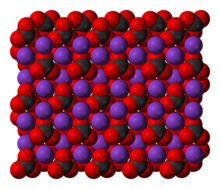Potassium carbonate
Appearance
 | |
 | |
 | |
| Names | |
|---|---|
| IUPAC name
Potassium carbonate
| |
| Other names
Carbonate of potash, dipotassium carbonate, sub-carbonate of potash, pearl ash, pearlash, potash, salt of tartar, salt of wormwood.
| |
| Identifiers | |
3D model (
JSmol ) |
|
| ChEBI | |
| ChemSpider | |
ECHA InfoCard
|
100.008.665 |
| E number | E501(i) (acidity regulators, ...) |
PubChem CID
|
|
RTECS number
|
|
| UNII |
|
CompTox Dashboard (EPA)
|
|
| |
SMILES
| |
| Properties | |
| K2CO3 | |
| Molar mass | 138.205 g·mol−1 |
| Appearance | White, hygroscopic solid
|
| Density | 2.43 g/cm3 |
| Melting point | 891 °C (1,636 °F; 1,164 K) |
| Boiling point | Decomposes |
| 110.3 g/(100 mL) (20 °C) 149.2 g/(100 mL) (100 °C) | |
| Solubility | |
| Acidity (pKa) | 10.25 |
| −59.0·10−6 cm3/mol | |
| Thermochemistry[1] | |
Heat capacity (C)
|
114.4 J/(mol·K) |
Std molar
entropy (S⦵298) |
155.5 J/(mol·K) |
Std enthalpy of (ΔfH⦵298)formation |
−1151.0 kJ/mol |
Gibbs free energy (ΔfG⦵)
|
−1063.5 kJ/mol |
Enthalpy of fusion (ΔfH⦵fus)
|
27.6 kJ/mol |
| Hazards | |
| GHS labelling: | |

| |
| Warning | |
| H302, H315, H319, H335 | |
| P261, P305+P351+P338 | |
| NFPA 704 (fire diamond) | |
| Flash point | Non-flammable |
| Lethal dose or concentration (LD, LC): | |
LD50 (median dose)
|
1870 mg/kg (oral, rat)[2] |
| Safety data sheet (SDS) | ICSC 1588 |
| Related compounds | |
Other anions
|
Potassium bicarbonate |
Other cations
|
|
Related compounds
|
|
Except where otherwise noted, data are given for materials in their standard state (at 25 °C [77 °F], 100 kPa).
| |
Potassium carbonate is the
anions CO2−3, and is therefore an alkali metal
carbonate.
History
Potassium carbonate is the primary component of potash and the more refined pearl ash or salt of tartar. Historically, pearl ash was created by baking potash in a kiln to remove impurities. The fine, white powder remaining was the pearl ash. The first patent issued by the US Patent Office was awarded to Samuel Hopkins in 1790 for an improved method of making potash and pearl ash.[5]
In late 18th-century North America, before the development of baking powder, pearl ash was used as a leavening agent for quick breads.[6][7]
Production
The modern commercial production of potassium carbonate is by reaction of potassium hydroxide with carbon dioxide:[3]
- 2 KOH + CO2 → K2CO3 + H2O
From the solution crystallizes the
calcined
:
- 2 KHCO3 → K2CO3 + H2O + CO2
Applications
- (historically) for dishware production;[citation needed]
- as a dietary potassium supplement, containing 56% of elemental potassium,[8] in tablet or powder form to address low blood potassium levels caused by inadequate nourishment, nausea and vomiting, diarrhea, or potassium-depleting medications such as corticosteroids or diuretics;[9][10]
- as a mild drying agent where other drying agents, such as calcium chloride and magnesium sulfate, may be incompatible. It is not suitable for acidic compounds, but can be useful for drying an organic phase if one has a small amount of acidic impurity. It may also be used to dry some ketones; alcohols, and amines prior to distillation.[11]
- in hartshorn;[citation needed]
- in the aroma—the process of adding potassium carbonate to cocoa powder is usually called "Dutching" (and the products referred to as Dutch-processed cocoa powder), as the process was first developed in 1828 by Dutchman Coenraad Johannes van Houten;[citation needed]
- as a ]
- in antique documents, it is reported to have been used to soften hard water;[12]
- as a fire suppressant in deep-fat fryers and various other B class-related fires;[citation needed]
- in condensed aerosol fire suppression, although as the byproduct of potassium nitrate;[citation needed]
- as an ingredient in welding fluxes, and in the flux coating on arc-welding rods;[citation needed]
- as an farmed animals such as broiler breeder chickens;[citation needed]
- as an acidity regulator in Swedish snus snuff tobacco.[citation needed]
References
- )
- ^ Chambers, Michael. "ChemIDplus - 584-08-7 - BWHMMNNQKKPAPP-UHFFFAOYSA-L - Potassium carbonate [USP] - Similar structures search, synonyms, formulas, resource links, and other chemical information". chem.sis.nlm.nih.gov. Archived from the original on 2014-08-12.
- ^ ISBN 3-527-30673-0.
- ^ List, Jenny (October 19, 2022). "Crusty Leaking Cells Kill Your Tech. Just What's Going On?". Hackaday. Archived from the original on May 30, 2023.
- ^ "Milestones in U.S. patenting". www.uspto.gov. Archived from the original on 2023-03-22. Retrieved 2023-08-04.
- ^ See references to "pearl ash" in "American Cookery" by Amelia Simmons, printed by Hudson & Goodwin, Hartford, 1796.
- ISBN 978-0-252-04108-2.
- .
- ^ "Office of Dietary Supplements - Potassium". Archived from the original on 2022-08-11. Retrieved 2024-12-18.
- ^ "Potassium Carbonate: What is it and where is it used?". Archived from the original on 2024-07-17. Retrieved 2024-12-18.
- ^ Leonard, J.; Lygo, B.; Procter, G. "Advanced Practical Organic Chemistry" 1998, Stanley Thomas Publishers Ltd
- ^ Lydia M. Child (1832). The American Frugal Housewife.
Bibliography
- A Dictionary of Science, New York, 2004
- Yu. Platonov, Andrew; Evdokimov, Andrey; Kurzin, Alexander; D. Maiyorova, Helen (29 June 2002). "Solubility of Potassium Carbonate and Potassium Hydrocarbonate in Methanol". Journal of Chemical & Engineering Data. 47 (5): 1175–1176. .

